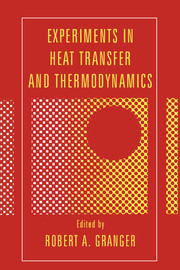Book contents
- Frontmatter
- Contents
- Preface
- Introduction
- Part I Experiments in heat transfer
- I.1 Conduction
- I.2 Convection
- I.3 Boiling
- I.4 Mixing, dispersion, and diffusion
- I.5 Radiation
- I.6 Heat pipes and exchangers
- Part II Experiments in thermodynamics
- Experiment 26 Effect of surface condition on attainable superheat of water
- Experiment 27 Experiments for compressibility and vapor pressure
- Experiment 28 Determination of time constants
- Experiment 29 Very fast versus very slow processes: Which are more efficient (closer to reversibility)?
- Experiment 30 Determination of volumetric fraction of each phase in multiphase flow
- Experiment 31 Measurement of the latent heat of vaporization of a liquid
- Experiment 32 Dilution techniques for the performance evaluation of continuous-flow combustion systems
- Appendix 1 Experiments and demonstrations in thermodynamics
- Appendix 2 Experiments and demonstrations in heat transfer
- Appendix 3 Heat-transfer and thermodynamic films
- Index
Experiment 32 - Dilution techniques for the performance evaluation of continuous-flow combustion systems
Published online by Cambridge University Press: 05 June 2012
- Frontmatter
- Contents
- Preface
- Introduction
- Part I Experiments in heat transfer
- I.1 Conduction
- I.2 Convection
- I.3 Boiling
- I.4 Mixing, dispersion, and diffusion
- I.5 Radiation
- I.6 Heat pipes and exchangers
- Part II Experiments in thermodynamics
- Experiment 26 Effect of surface condition on attainable superheat of water
- Experiment 27 Experiments for compressibility and vapor pressure
- Experiment 28 Determination of time constants
- Experiment 29 Very fast versus very slow processes: Which are more efficient (closer to reversibility)?
- Experiment 30 Determination of volumetric fraction of each phase in multiphase flow
- Experiment 31 Measurement of the latent heat of vaporization of a liquid
- Experiment 32 Dilution techniques for the performance evaluation of continuous-flow combustion systems
- Appendix 1 Experiments and demonstrations in thermodynamics
- Appendix 2 Experiments and demonstrations in heat transfer
- Appendix 3 Heat-transfer and thermodynamic films
- Index
Summary
Object
In the design of continuous-flow combustion systems, an important performance requirement is that combustion must be sustained over a wide range of operating conditions. For the combustors employed in aircraft gas turbines, this poses special problems because they are often called upon to operate at very low inlet temperatures and pressures and at fuel/air ratios that lie well outside the normal burning limits of hydrocarbon–air mixtures.
The stability performance of a continuous-flow combustor is usually expressed in the form of a stability plot that separates the regions of stable and unstable combustion. The traditional plot has equivalence ratio or fuel/air ratio as the ordinate, and some loading parameter, such as air velocity or air mass flow rate through the combustor, as the abscissa. A plot of this type is often called a stability loop, owing to its shape, as illustrated in Fig. 32.1.
Background
Stability loops provide two basic kinds of information. First, for any given fuel/air ratio, they indicate the blowout velocity UBO, which is the gas velocity at which flame extinction occurs. Attention is usually focused on the maximum blowout velocity, which tends to coincide with mixture strengths that lie close to the stoichiometric value. Second, for any given combustor loading, they show the range of fuel/air ratios over which stable combustion can be achieved.
- Type
- Chapter
- Information
- Experiments in Heat Transfer and Thermodynamics , pp. 245 - 256Publisher: Cambridge University PressPrint publication year: 1994



